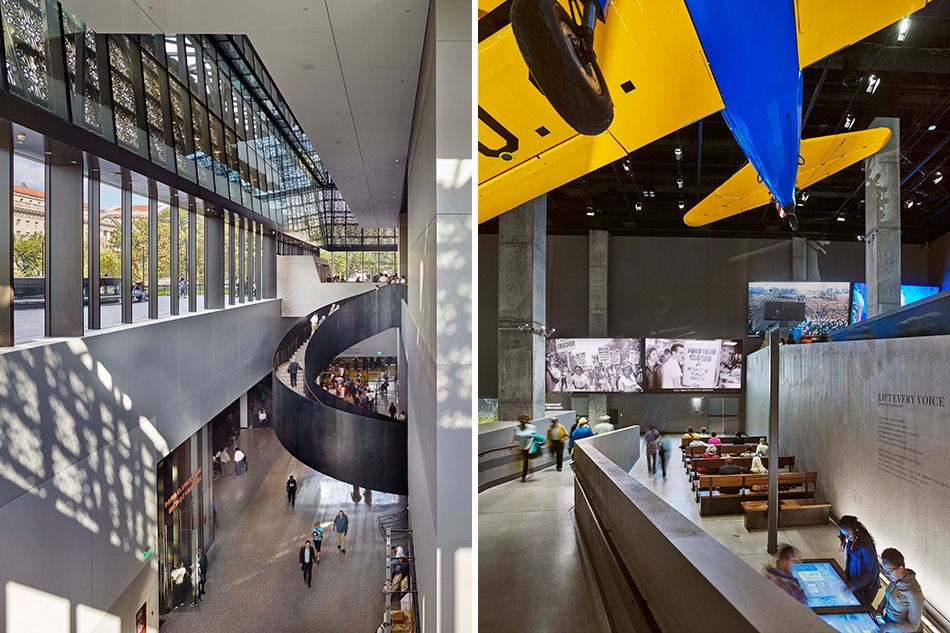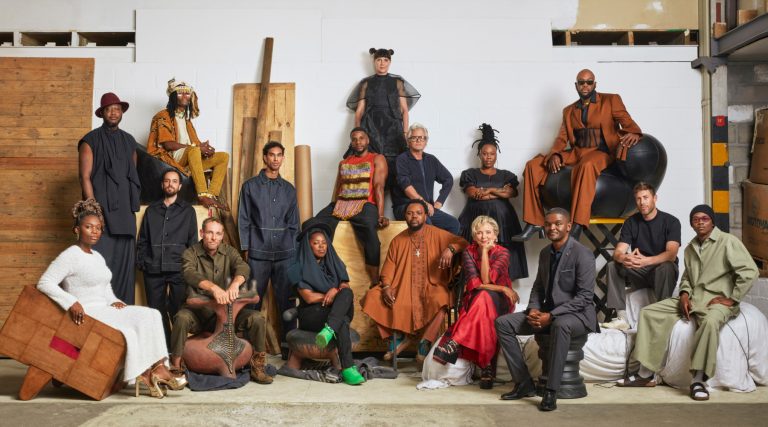
January 16, 2017The David Adjaye–designed National Museum of African American History and Culture, which opened in September, is the newest addition to the National Mall and perhaps the most highly anticipated. Top: The cast-aluminum facade is covered in a pierced pattern based on iron work by African Americans. Photos by Alan Karchmer/NMAAHC
This month, Washington, D.C., will be the obvious focal point of the country and the world: Donald J. Trump will be sworn in as president.
But anyone who shows up in our nation’s capital to cheer, or to protest, that event will also have the city’s somewhat underappreciated art and culture buffet to graze upon. Often overshadowed by New York, whose artistic offerings are just an Acela or Delta Shuttle ride away, Washington has stepped up its cultural game in the last few months.
Particularly worth visiting are two D.C. projects that stand at opposite poles of museum design these days: a boffo piece of brand-new starchitecture and, just a few blocks away, a subtle renovation and expansion of an iconic building.
Tanzanian-born British architect David Adjaye’s 400,000-square-foot building for the National Museum of African American History and Culture (NMAAHC), which debuted in September (and cost north of $500 million), has soaked up an enormous amount of attention. I’ve never been to a museum more deluged with visitors or more packed with information. It’s an intense, dense experience and one that seemingly everyone wants to be a part of.
The NMAAHC, some 9 years in the making, mixes fascinating history — you can learn about the hideous journey of slave ships and quirky Southern foodways, along with hundreds of other topics — with stunning artifacts. The guard tower from Louisiana’s Angola prison looms over visitors, who are later charmed by Chuck Berry’s Cadillac.

The museum’s galleries highlighting slavery and Reconstruction are underground, while the galleries featuring African American artists and pop culture icons are in the brighter, airier upper levels. Photo by Alan Karchmer/NMAAHC
The structure is fairly simple: a core of programmable space wrapped in an envelope for circulating among the floors. But the exterior is distinct, clad in panels with a complex pierced pattern and sporting a capital inspired by the three-tiered crowns used in Yoruban art.
“The building is a cast-aluminum skin with a coating on it,” Adjaye says. “So it has a bronze appearance. It’s based on ironwork from Charleston.” He adds that under slavery, “if you weren’t in the army, [the ironworkers guild] was probably one of the guilds you were in as an African American.” The cladding is therefore an homage to a craft that black Americans, in the worst of times, helped to develop.
Adjaye was determined to honor the subject matter of the museum while also fitting it into a very specific context: the grand procession of Smithsonian museums along the National Mall, which ends in a row of institutions on the southern perimeter that he calls the “hinge point.”
“It’s not just a standard ‘palace,’ ” Adjaye explains. “It’s something that has to end that sequence and address these conditions.” To reduce the footprint, he says, “we put more than fifty percent of the building underground.”
That decision is part of what makes going through the museum such an emotional journey. You start in grim blackness, beneath the earth, with the galleries that deal with slavery and Reconstruction. Soaring ceilings make you feel as if you’re at the bottom of a well.
But as you ascend to the above-ground floors, the mood becomes more buoyant. Although pop culture is the driving force through much of these upper galleries, there is a small room with excellent works by top African American artists, including Romare Bearden, Lorna Simpson, Kara Walker, Sam Gilliam and Jacob Lawrence. It’s one of the quietest spaces in the museum.

Architect Perry Chin updated I.M. Pei’s design of the National Gallery of Art’s East Building, adding 12,250 square feet. Photo by Dennis Brack/Blackstar. Courtesy of the National Gallery of Art, Gallery Archives
Three very long D.C. blocks away is the East Building of the National Gallery of Art (NGA), whose $69 million makeover debuted the same September week as the NMAAHC. As with good plastic surgery, you won’t necessarily notice the changes at first.
I.M. Pei’s 1978 design has always been a bit difficult to navigate — the atrium at its heart breaks up the gallery spaces in a way that can stifle circulation. This renovation, which added 12,250 square feet of space within the existing footprint, doesn’t solve every problem. But it helps the flow and adds excellent new spaces for art, so it’s all to the good. The design was spearheaded by Perry Chin, a protégé of the now 99-year-old Pei, who gave the scheme his blessing.
A whole new floor was essentially added on top, with big, beautiful sky-lit spaces in the towers at either end. Between the towers is a lovely outdoor sculpture space anchored by Katharina Fritsch’s Hahn/Cock, 2013, a large blue sculpture of a rooster that is among D.C.’s most frequent backgrounds for Instagram selfies.
“We got fifty percent more space for the permanent collection and a total reassigning of the galleries,” says Harry Cooper, the NGA’s head of modern and contemporary art, who got to reinstall some 500 works as part of the three-year renovation. “It’s a quiet revolution.”
Special exhibitions were moved down to the concourse level, below ground, freeing up lots of other space. “The mezzanine and upper levels have a linear flow of rooms and better size for large works,” says Cooper, citing the beauty of Al Held works paired with Jean Dubuffet and separate marquee rooms set aside for Ellsworth Kelly and Mark Rothko, two of the artists the NGA is strongest in. The Rothko space, suffused with filtered light, is a particular highlight.
“It wasn’t just that I wanted more works on view,” he says. “It was getting a sense of history. I had in mind MoMA’s two floors of permanent-collection painting and sculpture.”
The success of the project can be measured in the reaction by artists whose works are on view there. Richard Prince, Cecily Brown and Frank Stella were among the luminaries who attended the opening. “They all came and hung out,” says Cooper. “They wanted to stay and not go out to dinner.”
You’ll want to linger too.











